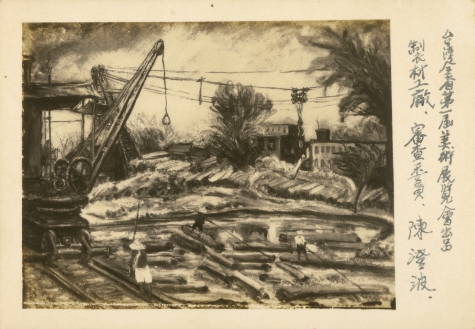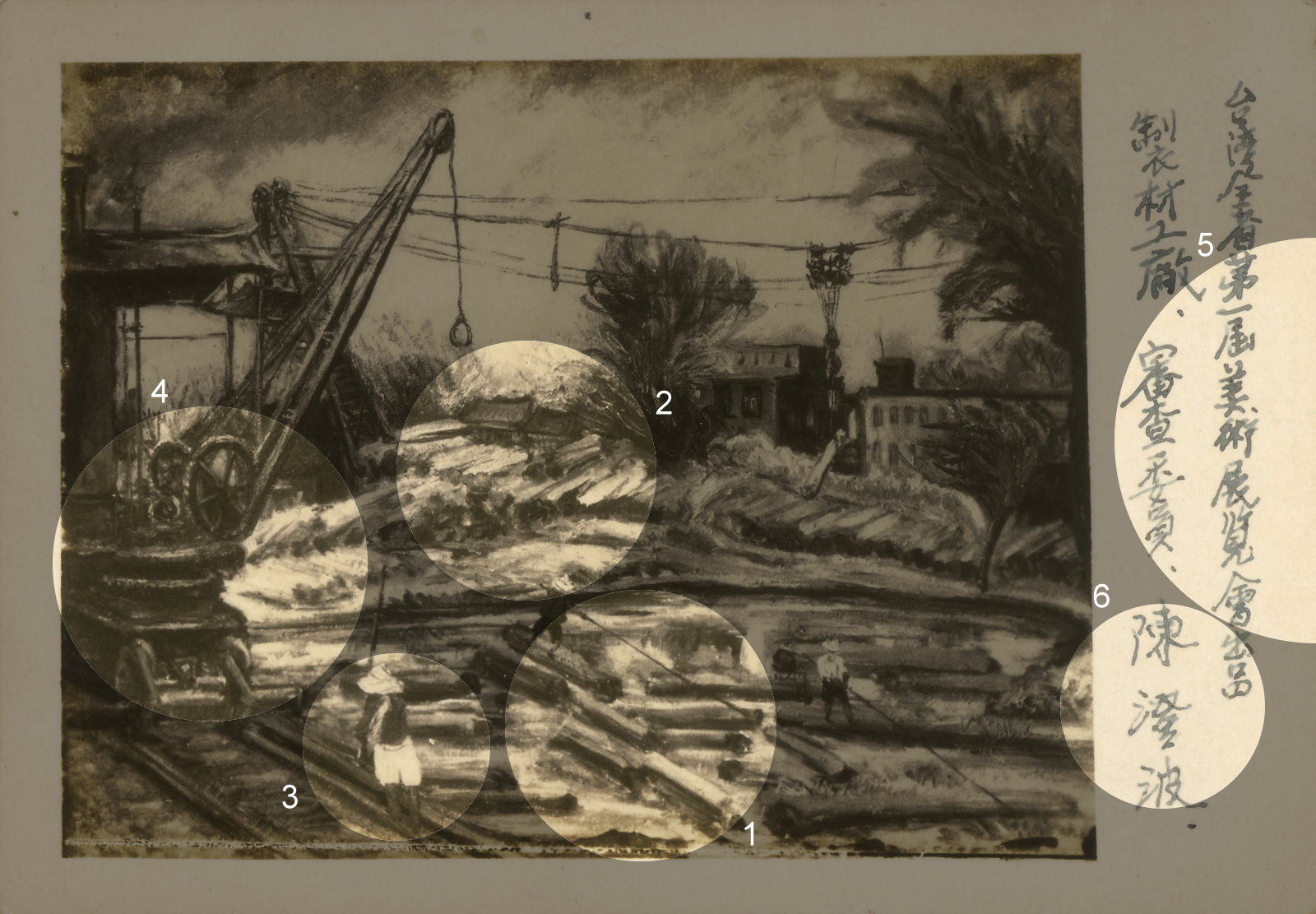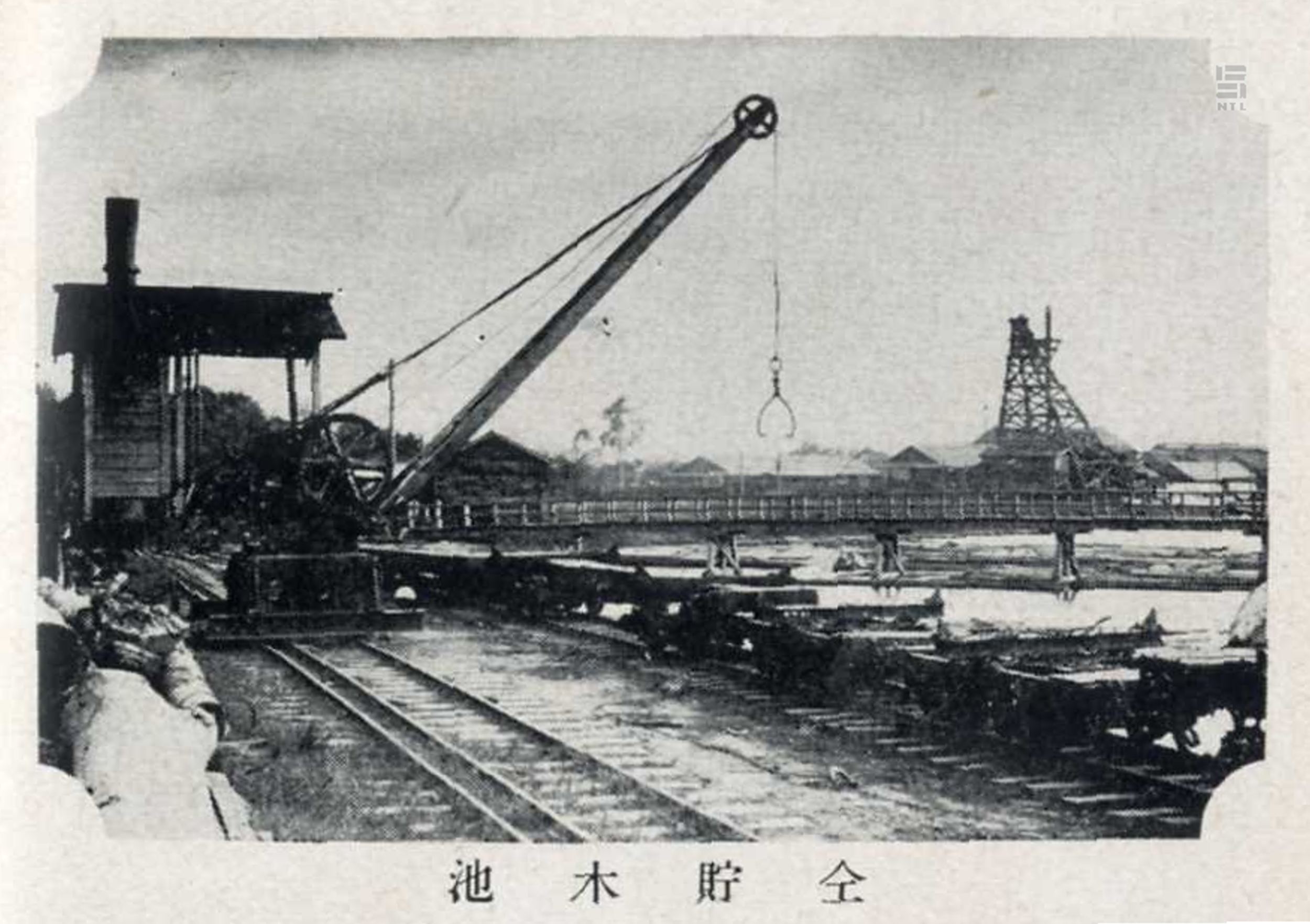製材工廠
為提供使用者有文書軟體選擇的權利,本文件為ODF開放文件格式,建議您安裝免費開源軟體 ([連結])

製材工廠
Sawmill
製材工場
1946, 畫布油彩, 91×116.5cm
oil on canvas
画布油彩
泛黃的舊照片雖然失去了油彩的顏色,畫面裡的風景卻依舊生動鮮明。起重機上的滑輪正飛快旋動,手持長竿的工人們則與池中的木塊奮力搏鬥。巨大的原木堆滿了整個廠區,即便戰爭才剛剛結束,工廠卻是一派繁盛欣榮。
Even though the vibrancy of the original oil painting is somewhat lost, a vivid and energetic scene emerges from this yellowed photograph. The pulleys on the crane spin swiftly round as workers use long poles to grapple with the unprocessed logs floating in the pond. Wartime had only just ended, but the sawmill is thriving and in full operation, with enormous logs piled high across the entire mill yard.
この油彩画はセピア色の古い写真の中ですっかり色褪せていますが、画中の風景は今なお鮮明で生き生きとしています。起重機の滑車が勢いよく回転する傍らで、長い竿を手にした労働者たちが、池に浮かぶ木材と格闘しています。工場の敷地いっぱいに巨大な原木が積み上げられているのを見ると、終戦を迎えたばかりとはいえ、工場はずいぶん繁盛しているようです。
在繪畫生涯的初始與末尾,陳澄波都曾來到嘉義製材場作畫。仔細比較這兩件作品,你又看見了哪些不一樣的變化呢?
This sawmill in Chiayi was a setting which Chen Cheng-po visited and painted at the beginning and end of his career as an artist. Studying these two works closely, can you perceive any differences?
陳澄波は自身の絵画人生の初めと終わりに、嘉義の製材場を訪れて作画しています。比較しながら2作をよくご覧ください。何か変わったところが見つけられるでしょうか。

1.貯木池
The log pond
貯木池
面積廣大的貯木池,嘉義人習慣稱為「杉池」,存放的是紅檜、扁柏等不會沉入水中的一級木。對於這類木材來說,泡水同時有助其品質的保養。據說原木釋放於水池裡的植物鹼有清潔功效,鄰近居民因此習慣到杉池洗滌衣物。
Commonly referred to as the “Chinese fir pond” by Chiayi residents, the large pond was used to hold Formosan and Taiwan cypress logs and those of other premium buoyant wood varieties. Soaking the logs helped to maintain the quality of their wood. Furthermore, alkaline substances released into the water by the wood were said to have cleansing properties, so neighboring residents would come to the pond to wash their clothes.
嘉義県の人々は広大な貯木池を「杉池」と呼んでいます。貯木池にはタイワンベニヒノキやタイワンヒノキなど、水中に沈むことのない一級品の木材が貯木されます。この種の木材は、水に浸けることで品質を保てます。原木を浮かべた池の水には洗浄力のあるアルカロイドが含まれるとされ、この付近の住民はいつも杉池で洗濯をしていました。
2.次級木
Different grades of wood
二級品の原木
從阿里山運送到製材場的大批原木,經過區分等級的檢尺工作後,便以不同的方式貯存。經濟價值較高的一級木會被送進貯木池,次級木則成批堆置於陸上的貯木場,等待買家標售。
Large loads of wood were transported from Alishan to the sawmill and then measured, sorted by grade, and stored on-site. Logs of more expensive, premium grades of wood were deposited into the log pond, while logs of lower-quality wood were stacked on the ground in great piles for buyers to inspect and bid upon.
阿里山から製材場に搬送されてきた大量の原木は、検尺を行った後、それぞれの等級に応じた方法で貯蔵されていました。高価な一級品は貯木池に送られ、二級品は陸上貯木場に積み置かれて、買い手が現れるのを待つことになります。
3.工人
The workers
職人
手持長竿、頭戴斗笠的工人,正使勁拉動貯木池裡的巨木。製材場的幅員遼闊,儘管有大型機具輔助,仍須倚靠人力來搬運場中的大量木材。在貯木池裡移動原木是相當危險的工作,稍一不慎,便可能跌落水池而喪失性命。
Wearing conical bamboo hats and grasping long poles, workers stood atop giant logs floating in the log pond, pushing and pulling them into place. The sawmill covered such an extensive area that even with the use of large-scale machines, its operation depended upon human labor to transport heaps of wood throughout the mill yard. Grappling with logs in the pond was dangerous work. If workers were distracted or careless for even a moment, they risked falling into the water and possibly losing their lives.
長い竿を持ち、笠をかぶった職人たちが、貯木池の太い原木を竿で動かしています。製材場の敷地は広く、大型機械の補助があったとしても、やはり人力で大量の木材を搬出しなければなりませんでした。貯木池の原木を移動させるのはかなり危険な作業で、少しでも気を抜くと、池に落ちて命を落とす恐れもありました。
4.起重機
The crane
起重機
座式起重機在軌道上來回移動,伸向貯木池的懸臂垂下吊索,隨時準備搬動池中的巨木。除了標誌性的天車之外,根據史料記載,製材場中還存在著一具荷重三噸、蒸汽動力的德製起重機,或許也就是陳澄波所描繪的這具機械。
The crane was constructed on a set of tracks upon which it could move back and forth along the edge of the log pond. With its boom and hoist rope extended over the water, the crane was ever ready for the task of moving the giant logs below. Historical records indicate that, in addition to a standard overhead crane, the sawmill had a German steam-powered crane capable of lifting three tons. This perhaps is the piece of machinery depicted in Chen’s painting.
固定式起重機がレール上を往復し、貯木池の片持ち梁にワイヤロープを垂れながら、池に浮かぶ巨木をいつでも運び出せるように準備しています。史料によれば、製材場にはシンボリックな固定式起重機のほか、蒸気機関で動く、荷重量3トンのドイツ製起重機もあったそうです。陳澄波が描いたこの機械がその起重機かもしれません。

1929年出版的《大嘉義》當中,已能見到這具起重機的身影。出處:嘉義街役場,《大嘉義》(大阪市:英進舍工場印刷,1929)。國立臺灣圖書館授權。
The silhouette of this crane appears as early as 1929 in Big Chiayi, published the same year. Source: Chiayi Town Hall, Big Chiayi (Osaka: Eishin Publishing House, 1929).
1929年に出版された『大嘉義』にもその起重機の姿が見える。出典:嘉義街役場,『大嘉義』(大阪市:英進舍工場印刷,1929)。
5.臺灣省第一屆美術展覽會
Taiwan Province’s first fine arts exhibition
台湾省第1回美術展覧会
1946年10月,已被中華民國政府接收為「省」的臺灣,在楊三郎、郭雪湖等畫家的積極爭取之下,仿照日治時期的「府展」,於臺北中山堂舉行了第一屆的美術展覽會,活躍於本地畫壇的陳澄波,也應邀擔任首屆省展的審查委員。
In October 1946, with the enthusiastic sponsorship of painters Yang San-lang and Guo Xue-hu among others, the Republic of China’s newly established Province of Taiwan hosted its first fine arts exhibition. The event was held in Taipei’s Zhongshan Hall and styled after the governmental exhibitions of the Japanese colonial period. As an active participant in Taiwan’s art circle, Chen was invited to serve on the panel of judges for the exhibition.
1946年10月、台湾はすでに中華民国政府に「省」として接収されていました。楊三郎や郭雪湖などの画家たちによる積極的な働きかけの結果、日本統治時代の「府展」に倣い、台湾省第1回美術展覧会が台北中山堂で開催されました。台湾の画壇で活躍する陳澄波も招きに応じ、初開催される省展の審査委員を務めました。
6.仍待尋找的畫作
The missing painting
所在不明の作品
在1947年的二二八事件發生之後,陳澄波的名字成為一種禁忌,其畫作也因此遭到隱匿,甚至銷毀。透過現存史料,我們知道這幅畫在省展結束後便被行政長官公署買下,呈獻給蔣介石。但這幅畫的下落迄今不明,僅存翻攝影像。
After the February 28th Incident of 1947, it became taboo to utter Chen’s name and his paintings suffered a similar fate. Many were hidden away; some were even destroyed. Historical records document that this painting was purchased by the Chief Executive Office after the provincial art exhibition and then presented to Chiang Kai-shek. However, its present whereabouts are unknown and all that remains is this photographic reproduction.
1947年に勃発した二二八事件以降、陳澄波の名は一種のタブーとなり、またその画作も秘匿され、処分された作品すらありました。現存史料によれば、この作品は省展終了後、行政長官公署が購入し、蒋介石に進呈されたそうです。しかし、現在は所在不明となっており、写真が残されているのみです。
